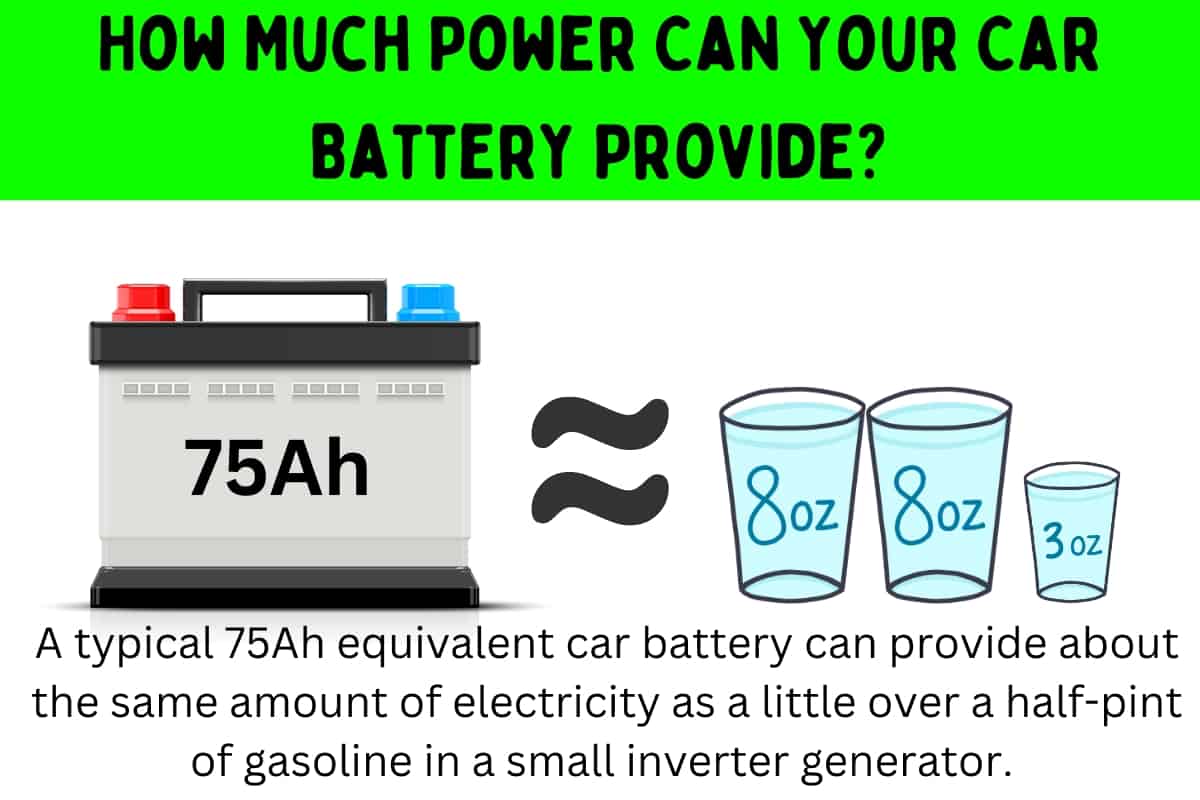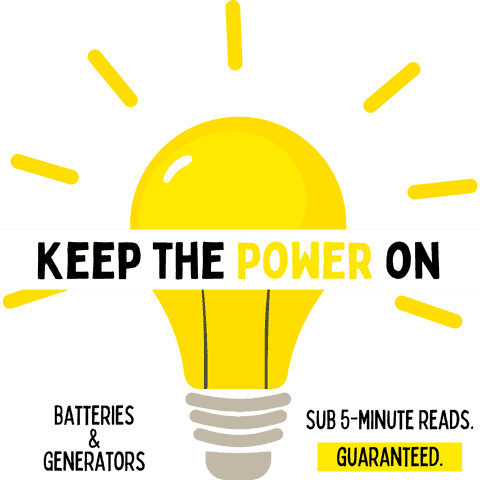When the power goes out most of us will still have at least one source of power readily available — our car battery.
This hefty box of 12-volts of DC electricity is a very potent item for turning over the engine in your vehicle, even on the coldest days, but is is it suitable for powering household items in a makeshift manner during a blackout or emergency?
A Car Battery is NOT Great for Powering a House, and Here’s Why
Car batteries have their place, and that place is in your car for starting your engine. Sure, they’ve got a lot of potential for powering low draw applications, but that’s about it.
Let me show you what we’re working with when we compare a car battery to a small inverter generator.
A small WEN inverter generator (Amazon) with 1900 running watts can run at half load (950 watts) for 5.7 hours on 1.06 gallons of gasoline.
The average car battery is 75Ah (ampere hours) in equivalency.
To see how these stack up we multiply 12-volts by 75Ah and we get 900Wh
We then multiply the 950 watts from the generator by 5.7 hours and we get 5,415Wh total output on 1.06 gallons of gas.
900Wh / 5,415Wh = 0.166
0.166 x 1.06 gallons of gas = 0.176 gallons of gas

In other words and at this point in the math, the average car battery has 17.6% of the available energy as a typical inverter generator with just over a gallon of gasoline. 17.6% of 128 ounces per gallon is 22.5 ounces — which is just over half a quart of gasoline.
We haven’t even considered the 15% average inefficiency of the energy that will be lost by the inverter that switches the battery’s DC power in to AC power for your appliances!
If we take that into account, we’re looking at a battery that is worth about 19.125 fluid ounces of gasoline (22.5 x 0.85).
So, keep in mind that when you want to power something with your car battery during an emergency that you’re working with a maximum of 19 fluid ounces from a small inverter generator. That’s barely more than 2 measuring cups of liquid, or a bit shy of the size of a Venti cup from Starbucks. This is also assuming your battery is in good health and fully charged to begin with.
It’s not going to get you very far — especially if you choose to power something that requires a lot of electricity.
Here’s What to Power in Your House and What to Avoid with a Car Battery
Now that we’ve established in the previous section that your car battery’s worth to you in energy is roughly equivalent to a tall coffee cup of gasoline in a generator.
Where a battery shines is in powering low draw applications and for powering things at night when it might be impractical or unsafe to run a generator. Charging devices, powering an LED light or two, and maybe a radio should be about all the stress you put on a car battery if you can help it.
| Item or Appliance | Watts (or Battery Capacity) | How Long Can a 75Ah Car Battery Power It |
|---|---|---|
| 1 LED Bulb | 9 Watts | 85 Hours |
| 1 Incandescent Bulb | 100 Watts | 7 Hours |
| Samsung S21 | 4,000 mAh (15.4Wh) | 58 Charges |
| iPhone 14 | 3,279 mAh (12.68Wh) | 70 Charges |
| Chromebook | 51Wh | 17 Charges |
| Router and Modem (Combined) | 8 Watts | 95 Hours |
| 50″ LED Smart TV while Streaming | 92 Watts | 7.5 Hours |
| Dual Window Fan (High Speed) | 56 Watts | 13 Hours |
| Box Fan (High Speed) | 95 Watts | 7.5 Hours |
| Clock Radio | 2 Watts | 450 Hours |
| Coffee Maker (Single Cup) | 1,100 Watts (for 3 Minutes) | 30 Minutes (10 Sessions) |
| Coffee Maker (Whole Pot) | 1,000 Watts (for 11 Minutes) | 33 Minutes (3 Sessions) |
| Microwave | 1,650 Watts | 18 Minutes |
| Blow Dryer (Low Heat) | 865 Watts | 38 Minutes |
| Blow Dryer (High Heat) | 1,715 Watts | 18 Minutes |
| 1/3 HP Sump Pump | 700 Running Watts, 1,450 Starting Watts | 48 Minutes |
| 1/2 HP Sump Pump | 900 Running Watts, 1,850 Starting Watts | 36 Minutes |
The tables above will give you a general idea of how long you have to power something with your car battery until it is empty. This is not taking into account that you’re probably going to want to keep at least 50% of the state of charge in your battery (or more) to turn over your car’s engine if you need it. If you still need to start your car, then you’ll want to cut these numbers by half or 2/3 just to be safe.
It’s also not taking into account that each inverter (converts battery DC power to usable AC power for appliances) will squeal and turn off when the battery voltage drops too low but isn’t yet fully discharged. Reduce these numbers by at least 10% to be conservative.
How to Power Appliances with a Car Battery
Car batteries have direct current (DC) electricity and our household appliances require alternating current (AC) electricity, like the kind that comes from your wall receptacle.
In order to power these appliances, you’ll need a power inverter which serves to make that electrical inversion. This inversion comes with about a 15% inefficiency factor. So, if you’ve got a 50-watt appliance, it’s going to actually be pulling 58.8 watts from the battery to overcome the energy lost during the power inversion (50/0.85).
The inverter hooks up directly to battery terminals and the appliance plugs into the inverter. The battery can still be attached to the car, or it can be removed and brought inside. Starting your car’s engine every once in a while will help charge it back up if you’ve been using it for a while — especially if you can drive it around for at least 30 minutes.
You need to choose an inverter that has high enough running watts (and starting watts, if applicable) to what you plan on powering. A 800-watt inverter will not power a microwave that demands 1,600 watts.
Inverters come in modified and pure sine wave formats. Modified is cheaper and is fine for appliances without sensitive electronics or compressors. Electronics with microprocessors and appliances with compressors are best to use with a pure sine wave inverter which delivers cleaner electricity.
Finally, you can always power appliances while your car battery is hooked up to your car and the car is running. Connect the inverter and plug an extension cord into it to bring in the house. Obviously, keep the car outside so the exhaust does not build up in the garage.
There will be some voltage drop depending on the length of your extension cord, but it’s a way to power some of the larger items while allowing the engines alternator to do a lot of the work (which, unfortunately, can also prematurely ruin your alternator).
Alternatives to Using a Car Battery for Power
Obviously, a generator — either conventional or an inverter — would be preferable to powering your household appliances. Inverter generators are quieter but are for smaller loads (generally 5,000-watts or less).
Car batteries are not designed for deep-discharges and easily sulfate when you use them for such applications. Lead-sulfate on the plates inside the battery will dramatically reduce its serviceable life and effectiveness. A car battery can be fully discharged only 10-12 times before it will no longer hold a charge.
If you are set on using a battery for your electrical needs, then it is best to look at getting a marine deep-cycle battery or a pair of 6-volt GC2 golf cart batteries that are hooked together in series to make 12-volts. These batteries can be fully discharged 150-200 times and cost roughly the same as a car battery.
